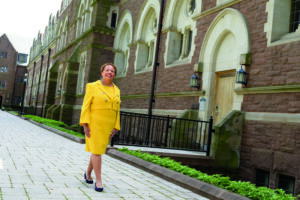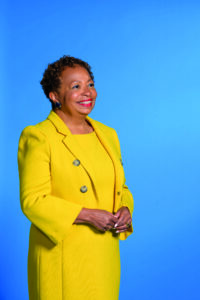A Conversation with the President
Joanne Berger-Sweeney shares insights on Trinity, her time at the College, and more
A little more than a decade ago, in July 2014, Joanne Berger-Sweeney became the 22nd president of Trinity College. Not long after, the two of us met in her office in Williams Memorial to talk about her plans and her hopes for her time ’neath the elms. And now, as Berger-Sweeney prepares to embark on her 11th and final year at Trinity’s helm, I’m in her office once again, this time seeking her thoughts as she looks back on her tenure and what she sees possible in the College’s future.
What were some of your proudest moments at Trinity? Commencements are the culmination of the academic year and signify so much about what’s important in our community: recognizing the achievements of our students. All the people who made the student experience possible—including faculty, staff, and families—are there for this joyous celebration. Commencements really are pure joy.

What do you consider your most significant achievements as president? First and foremost, we have more engaged students who are stronger in so many ways. A larger percentage of our students are stronger academically. Our students are more civic-minded and engaged. I like to use the example of looking at voting rates of our students in the presidential elections in 2016 and 2020; the rates almost doubled, and that to me is a sign of an engaged student body. The students are more diverse around virtually every metric that you can think of. There are more international students. Our population is a little more racially and ethnically diverse than it was when I walked in the door. The socioeconomic diversity is greater, and once again, that’s providing access to a Trinity education for a wider variety of students. We have stronger academic and co-curricular experiences that meet our more engaged students. This is the heart and soul of our mission, and I am exceedingly proud of this, as well as our successes with our strategic plan, Summit.
Second is the greater engagement of the full Trinity community with one another and the College; that was on full display during our Bicentennial. To have a Bicentennial for a campus that has about 3,000 campus members and to have engaged more than 11,000 attendees in our Bicentennial activities just underscores the sense of community that we have, and that community includes alums, trustees, faculty, staff, students, and those in our neighborhood. It was a wonderful opportunity to see our connected community on display.
Third is our stronger connection with Hartford. Over 200 years, the relationship between Trinity and Hartford has waxed and waned. Since I’ve been here, it has been strong, probably the strongest in recent history. I have been very connected to the Greater Hartford community, and I’ve watched so much amazing development, from Trinity’s Innovation Hub downtown, to the Liberal Arts Action Lab, to my involvement with Hartford HealthCare. It’s just been a glorious opportunity to underscore that Trinity is and of Hartford.
What is your favorite place on campus? I do believe my favorite spot is the Chapel. I love the architecture. I love the sense of solace that you have going in. Even though people might equate it with a church, I truly see it as a multifaith place to be on campus where different traditions and cultures are welcomed. And then you add the Austin organ into the mix, and you realize that you have a truly unique place. The Chapel connects our past and traditions with our hope and aspirations for the future. You look around the building, and you see the history. But then you notice some of the new things going in, including the Chapel of the Perfect Friendship that was dedicated by the Class of 1963 just two years ago—it wasn’t just an homage to the past, it’s what they hope is enduring to the future, which is friendship—and the first African American chaplain leading us into a pluralistic third century.
What are some memories you think will stay with you forever? One of my earliest and best memories was my inauguration. It was simply outstanding, and I still remember well the samba band that ushered me in. I remember “America the Beautiful” being sung by this choir of differently trained voices. Hartford-area college and university presidents came to support me, along with my friends and family members from different generations of my life. I remember looking out to a sea of faces that were just so welcoming and hopeful. I remember all the officials; the mayor came, the governor came and spoke, the different representatives of constituent groups all wishing me well with such joy and anticipation. Who wouldn’t want to come into that community with that on display? I will carry that with me forever.
What will you miss the most about Trinity? There’s no doubt I will miss the people, but with Zoom, with telephones, there are ways to keep in contact with people. I will miss the place. I will miss being able to walk out of my front door and be in a 100-hundred-acre arboretum, in a National Historic District. The physical beauty of the space and the importance of aesthetics in your life cannot be underestimated. [We have] green in the middle of the city. There’s something quite special about this combination we have here.
What were some of the biggest challenges you faced, and how did you navigate them? There were so many challenges, and I don’t know where to start on which of them was the most significant because each and every one of them in that time felt all-consuming. I think I have one of the strongest administrative teams in higher education, and we collectively figured it out. It wasn’t any one individual; it was groups coming together, assembling, reassembling into different groups depending on what the particular crisis was. The team was composed of smart people who cared passionately—and still care—about Trinity. We stood together as a team, both my administrative team and so often the Board of Trustees. We wanted what was best for Trinity and its future and never lost sight of the goal. We just kept moving the institution forward, and we will continue to do so in the future.

What do you hope people will remember about you and your time at Trinity? I do hope they recognize that I care deeply about Trinity and trying to make it a stronger institution, that fundamentally I want to leave the place better than it was when I came. It isn’t about me; it is about a better Trinity and my hopes for higher education being better and stronger for the country.
How have you changed as a person during your time at Trinity? I have had to learn to be more flexible. I love to use the analogy that as president, you need to be more like a willow tree than an oak tree. A willow is deeply rooted but is able to navigate storms better and more often than the big, strong oak. I had to learn that flexibility as a leader, knowing what to fight for and what I cared mostly deeply about as well as what I had to let pass and roll off of me. I learned as president that you can’t control everything, that you don’t control as much as some may think because people behave the way they’re going to behave. Especially with 18- to-22-year-olds, you have to figure out how to set boundaries and also how to be empathetic, sympathetic, and forgiving because learning is so often about giving people just one more chance to get it right.
What are your goals for your last year as president? There are many projects that are close to fruition but are not done yet. Very high on my list is completing our comprehensive campaign. It’s why I decided to stay the additional year, after my 10-year contract, knowing that the campaign had been set back by COVID and various other issues. We also have some shared governance projects that I would like to see through to completion, and we have some financial goals for the College—investing in admissions, the academic program, the student experience, and advancement—that I would like to see on sure footing before I leave. And of course, I want to see one more beautiful graduating class and a smooth transition to the next leader.
What do you envision for Trinity’s future? Trinity’s future is incredibly bright. We have amazing students who turn into amazing alums. The connectedness and stickiness of this community is as strong as I have ever seen anywhere in higher education. When people care for others, how can the future not be bright? I also see a strengthening of the City of Hartford that will be an even better neighbor to Trinity. I see so many sparks of light in the city, and so often we say, “Hartford goes as Trinity goes, and Trinity goes as Hartford goes.” Since I have been here, I have seen continually strong leadership at the local, regional, and state level. And I think a place gets better not simply because of one good leader but by one good leader who follows another good leader. And I think Hartford and Connecticut have that pattern now, and Trinity will benefit from that. You can see the amazing renovations and building projects going on downtown and in the hospital district just a block away, and to have that kind of development will indeed strengthen the entire neighborhood in which Trinity is situated. There will be more amenities close by, there will be more people, more activity, more economic development. If we continue to be connected to the city and the city grows strong, it is absolutely a winning combination.
What advice would you give the incoming president? Hang in there! The Trinity community can be a little tough at first. It feels like a community that requires you to prove yourself. But once you do, the kind of support that you will get is phenomenal. Continue to try to build and instill pride in Trinity as an organization. It still can go through pangs of insecurity, which in my mind are unfounded. The new president is going to have to remind people of what an incredible place this is and has been for more than 200 years.
Anyone who has listened to any of your speeches knows you like to talk about books you’ve read. What’s on your reading list? I’m going to take a different angle to that. When people ask me what I would like to do when I retire, I have said that one of my dreams is to take courses in creative writing. So maybe it isn’t what I will read; it’s what I will try to write myself.
Interview by Sonya Storch Adams
Photos by Nick Caito
